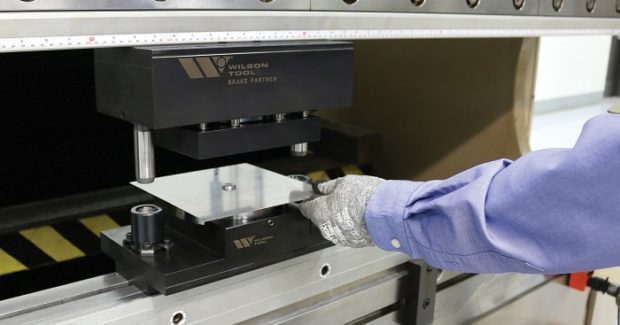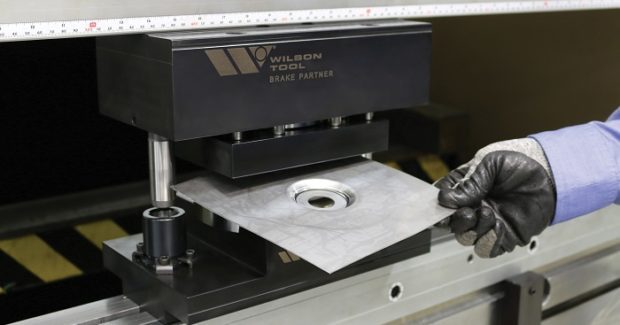Need More Punching Capacity? Turn Your Press Brake Into a Punch Press
Does limited punching capacity and outsourcing lead times cause production delays in your shop? Here is a simple, affordable and effective system that can expand the capabilities of your press brakes, help streamline operations and eliminate the need for outsourcing or purchasing new equipment.
Posted: April 12, 2019
Because punch presses share space in fabrication shops with laser cutting machines, many fabricators are realizing the value of the punch press and its ability to create forms. Whether your punch presses have been replaced by laser cutting machines or are simply running at full capacity, a new tooling holder makes it possible to produce forms using punch press tooling on the press brake. Our Brake Partner™ system enables shops to perform punch press operations in-house, even when no punching machine is available. Manufactured to fit virtually any press brake, this system allows the components of punch press style forming tools to be used on a press brake. Instead of using the existing turret tooling guide assembly designed for the punch press, the punch, stripper and die components are assembled with a new, innovative punch and die holder set. A new pressure-pad system provides both stripping and blank holding. The system uses guide pins to maintain alignment between the upper and lower units of the tool holder. If alignment isn’t an issue, the guide pins can be completely removed during forming.
The set up process for the Brake Partner is relatively straightforward. The punch press tooling is assembled in the holder prior to installing the holder in the machine. Operators will need to update the machine control with the geometry of the guided holder (supplied by us) prior to loading the holder into the press brake. Once loaded, the tool holder should be aligned using the guide pins, then seated and clamped into position. The guide pins can then be removed while the stops are set to the required machine stroke positions. This is a simple, affordable system for fabrication shops looking to meet forming needs in-house when, for one reason or another, no punch press is available. Its unique design enables them to perform some of the same functions as a turret press on a press brake, helping to streamline operations and eliminate the need for outsourcing or purchasing a new machine.
From a cost and efficiency standpoint, this unique solution allows fabrication shops with limited punching capacity to expand the capabilities of their press brakes. It eliminates the cost of investing in a new machine and minimizes production delays caused by outsourcing punching applications. The Brake Partner utilizes thick turret tooling; specifically, HP-style punches, lance and form style punch tips and an E-station die footprint. The system does not provide a solution for slug ejection, so piercing is not an option. It can be used with approximately 80 percent of the forms available in turret tooling, which means shops with existing punch press tooling may be able to use tooling they already own – resulting in even more cost savings. However, even if new tooling needs to be ordered, this system uses standard tooling priced from punching, which costs less and has shorter lead times than special press brake tooling. (Typical lead times for punch press tooling are a minimum of one day without testing to a maximum of ten days with testing, compared to press brake specials that are commonly being measured in weeks.)
Another benefit of this unique system is its potential to create form heights that exceed conventional punching machine maximums. And, with special-made punch tooling, even A-dimension limits may be exceeded. Both advantages would be impossible on a punching machine due to tooling footprint limitations. Forming on the press brake does present some limitations, such as no hole piercing or slug ejection. The tooling holder supports a minimum of .008 in total clearance. The press brake open height minimums depend on the type of press brake being used (see chart above). The use of guide pins limits the sheet processing size to eight inches or less, which is the amount of available space between the pins. The guide pins must be used in all thrusting and shearing applications to maintain alignment. However, in some forming applications where there is no thrusting or shearing, the guide pins can be removed, making it possible to form larger parts.







